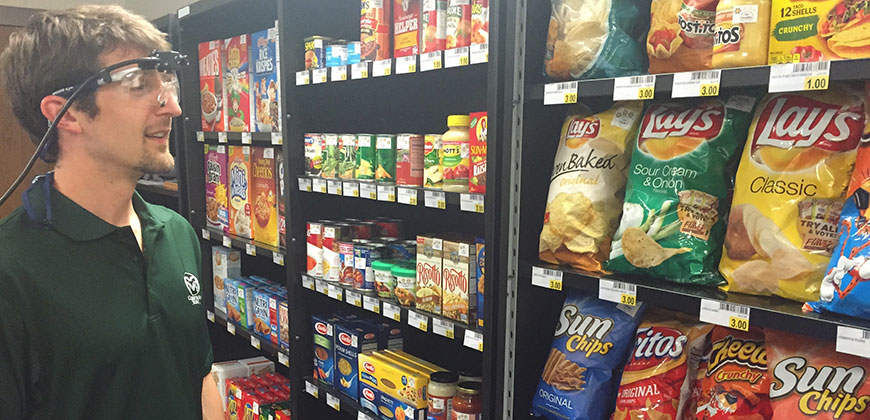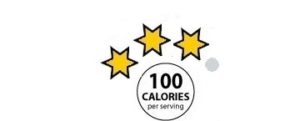
Dan Graham, assistant professor in the Department of Psychology, uses eye-tracking software to observe how people make food choices. He has a fake store set up in his lab. Credit: Katie Courage
This spring the U.S. unveiled a new, long-debated Nutrition Facts label, that black-and-white panel found on nearly 800,000 foods. Its contents could impact billions of decisions made each day – and public health for decades to come. That is, if people use it.
Since it was introduced in the 1990s, the Nutrition Facts has been the standard digest of a food’s healthfulness. And research has shown that the vast majority of Americans say they want to eat more healthfully.
So why, then, if the desire is there and the information is there, have obesity rates continued to climb?
This is the question that has fascinated Colorado State University’s Dan Graham, an assistant professor of psychology in the College of Natural Sciences. Graham is also a faculty member of the Physical Activity and Healthy Lifestyles concentration in the Colorado School of Public Health at CSU.
“It started looking to me like people weren’t using this information – or didn’t know how to use it,” he says, as he hops out from behind his treadmill desk to explain in more detail.
He began his career studying physical activity and how a combination of policy and psychology might help people move more. But he knew there was more to health and to the obesity epidemic than simply a lack of exercise. So he decided to extend his research to the food side of the equation, specifically, to how people really use nutrition information.
Tracking eyeballs for change
To understand human behavior, you can ask people what they do. But a more accurate measure is to monitor what they actually do. Many people say they use nutrition information, but Graham deploys highly sensitive eye-tracking cameras to record people’s attention. He and collaborator, Christina Roberto, who runs the Psychology of Eating and Consumer Health lab at the University of Pennsylvania, recently published a paper in Health Education & Behavior that examines how people used an updated Nutrition Facts box when evaluating products.
The new label, which will be required on packaging starting in 2018, includes a larger display of calories, updated serving sizes and a line displaying the amount of “Added Sugars.”
In the study, 155 young adults were asked if they would purchase various foods based on a photo, description, price, ingredient list and nutrition labeling. When the newer panel was displayed, more than half of participants spent substantial time looking at the “Added Sugars” line before making a decision.
Graham and Roberto submitted their findings to the FDA during its open comment period for the label updates. And the final new label, unveiled by First Lady Michelle Obama last month, fits with what they found in their research. “We hope it had something to do with our data,” Graham says with a smile.
Just the facts
For all its potential power, however, even the new Nutrition Facts label has a couple of drawbacks. One is that it still usually resides on the back or side of packages, hidden in most store displays. The other is that because the label aims to convey information about a lot of nutritional elements (fat, carbohydrates, vitamins, etc.), all the data can make it difficult to quickly judge which product is the “healthiest” overall.
That’s why the European Union, along with some companies and institutions, have experimented with simple front-of-package labeling for a snapshot of healthfulness. Many use a “stoplight” approach: green circle for low fat content, yellow for moderate, red for high fat, and with additional colored circles for sugar or salt. This lets consumers quickly scan a store shelf and compare foods based on these key health concerns. Front-of-package labels reach a lot more eyeballs: an average consumer might look at 10 front-of-package labels, but only two Nutrition Facts panels, Graham says.
Star shoppers
Graham and his collaborators at CSU are now testing out an even simpler label to help shoppers spot the healthiest choices.
They have created a fake market aisle in his lab in the Clark Building. There, study volunteers get $20 to spend on real foods, such as Chex cereal, Sun-Maid Raisins and store-brand pasta sauce. Half of the volunteers shop shelves where each package looks just like it does in the store. The other half encounter packages that have a customized sticker in the top right corner. This extra label displays the number of calories per serving and one to four stars as a measure of overall healthfulness, a labeling system recommended by the Institutes of Medicine (and fine-tuned by earlier research by Graham a CSU colleague). Canned beets get four stars. Kraft Macaroni-and-Cheese gets one star. And consumers can still check out the full Nutrition Facts.

As they shop, volunteers wear glasses with eye-tracking cameras so the researchers can see if – and how long – shoppers spend looking at the star labels – and then correlate that with the eventual purchasing decisions. The cameras can capture 1,000 eye movements per second.
The research team has partnered with local health nonprofit Vida Sana to recruit parents and children aged 5-10 years old. So far they have had more than 150 parent-child pairs don the glasses and “shop” for the study, which is wrapping up this summer.
The ultimate goal is to create labels that help people make healthy choices at a glance, Graham says. “We want to make it as easy for people as possible – so they don’t have to pick up the box.”